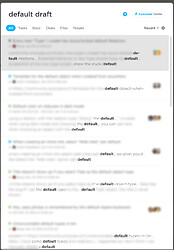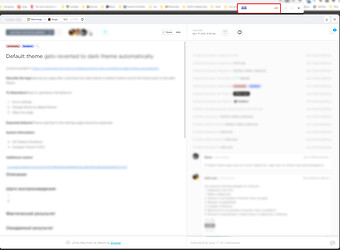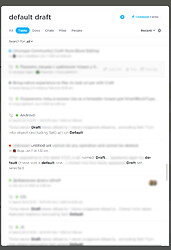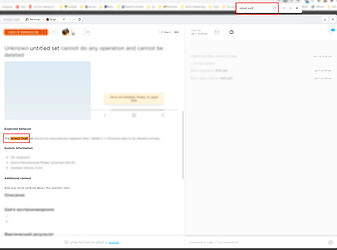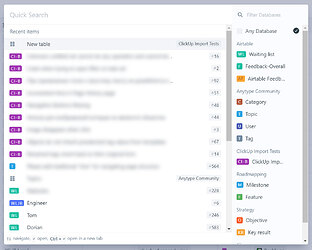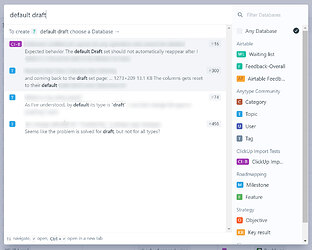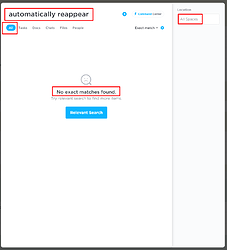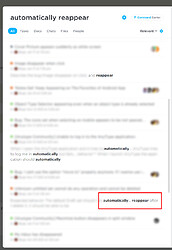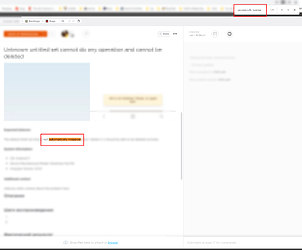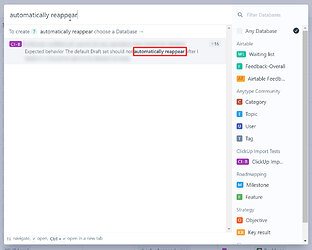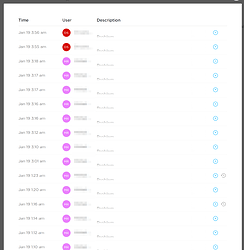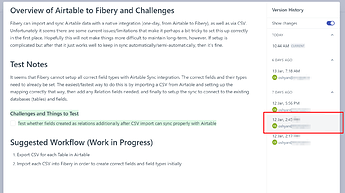Recently I was asked to do a comparison between the popular work management app ClickUp and the more under-the-radar “no code” tool Fibery, for the specific use case of managing a software development team - sorting, prioritizing, and working on bugs and feature requests, from both internal and external sources, roadmap planning and communication, etc, etc. This particular team uses a form of Agile, with classic Sprints.
ClickUp takes a very direct approach to addressing these needs, with dedicated task management, custom status and fields, task dependency, and more, and it even includes a dedicated Sprint Creation tool. Fibery, on the other hand, is much more of an open and flexible toolkit, and while there are Templates that give you a base structure to do much of the above, it’s also much more flexible in some respects (flexible but DIY). So in a situation where your workflow is a fairly common and well-understood one - software dev using Agile - does that flexibility really matter? How does Fibery compare in other, more fundamental work functions?
I considered some factors outside of the core software dev use case, and of course many features have broad utility, so I hope this comparison will prove useful to others as well.
Fibery vs. ClickUp Comparison
Preamble
Here is my admittedly biased but mostly evidence-based comparison. The team was using ClickUp to begin with, so I simply took their entire issue tracking data set (some 400 items) and imported it into Fibery via CSV so I could be operating on the same data for these tests. Then I ran through a variety of basic functions and areas to see how they compared for these particular uses.
I’m using a simple emoji to indicate whether ClickUp or Fibery comes out ahead in each area. When Fibery wins = ![]() , when ClickUp wins =
, when ClickUp wins = ![]() . Other emoji are used for a quick at-a-glance impression of my personal opinion on how they compare, they are not meant to be a consistent score. I have provided numerical ratings for clarity, where 1 = poor implementation or non-existent feature, and 5 = ideal implementation/feature.
. Other emoji are used for a quick at-a-glance impression of my personal opinion on how they compare, they are not meant to be a consistent score. I have provided numerical ratings for clarity, where 1 = poor implementation or non-existent feature, and 5 = ideal implementation/feature.
Task Management and Reminders 
Fibery: ![]() (3)
(3)
ClickUp: ![]() (5)
(5)
Simply put, ClickUp has better dedicated task management functions, easier reminders and task-related notifications. You can do a lot in this area in Fibery with the flexible toolset, but it’s more complicated and cumbersome, especially for initial setup, e.g. reminders require messing with automations to enable, and require a dedicated field on the Entity to set the date. It “just works” in ClickUp and is very easy to add notifications, adjust them, etc. Especially for things like recurring tasks. Once an admin gets task management working well in Fibery, it mostly also “just works”, but it’s still less flexible and easy to use, in my view.
Sprint Creation/Management  ?
?
Fibery: ![]() (?)
(?)
ClickUp: ![]() (3-4)
(3-4)
I know that ClickUp has a dedicated Sprint Creation/management function. I haven’t used it, so I’m not sure how good it is, but I do know Fibery doesn’t have that. ![]() That said, it’s possible ClickUp is too rigid, or that Fibery’s flexibility makes this fairly easy too, I’m not sure. They provide a template for Scrum setup that one can look at and test: https://fibery.io/templates/scrum-for-teams
That said, it’s possible ClickUp is too rigid, or that Fibery’s flexibility makes this fairly easy too, I’m not sure. They provide a template for Scrum setup that one can look at and test: https://fibery.io/templates/scrum-for-teams
Search 
Fibery:![]() (4)
(4)
ClickUp:![]() (2-)
(2-)
Search is way, way better in Fibery, at least in regards to speed and quality of results. It is far more precise, accurate, and useful. I think the examples that follow are fairly compelling, and quite honestly ClickUp’s results here just look… broken. I’m not sure what’s going on. For what it’s worth I’ve started with ClickUp’s defaults and then adjusted settings to try to get better results when those defaults basically failed.
To test some basic cases I chose two “Tasks” (bug reports) at random, found some adjacent words in them, and used that to test the search function in both ClickUp and Fibery. This was done entirely at random, and a few other attempts using other randomly sampled words yielded similar results (I’d be curious to hear from readers if their tests turn out better!). I’ve blurred much of the text, but left key words, etc. readable so you can see what matters.
Here I’m searching for the text “default draft”. You can see many instances of “default”, but none of “draft”. Hmm.
Now I open one of the results from that list and do an in-page text search for the original search term “default draft”. But what’s this? 0 results? ![]() Yes, the word “default” is present, but “draft” is nowhere in this record, not in Comments, attachments, or anywhere I could find. And of course the search results page didn’t show any highlight with that word, so I don’t even know where ClickUp thinks it is.
Yes, the word “default” is present, but “draft” is nowhere in this record, not in Comments, attachments, or anywhere I could find. And of course the search results page didn’t show any highlight with that word, so I don’t even know where ClickUp thinks it is.
Here’s another example, I opened another item from the original results list and searched for one of the two search terms. Not found. ![]()
OK, let’s give ClickUp a little help here and confine the search to just Tasks. Ah, finally we see a result that looks promising, with both words highlighted in the results list.
And when we open it, aha, we can see it! But… why wasn’t this exact match result, with both words right next to each other, even showing up in the original list? Especially when several of the results that did show up didn’t even seem to contain one of the search terms.
Finally when I confined the search to Issues Only and the specific list, then our match was at the top. OK, I thought, maybe the problem was that ClickUp had defaulted to sorting results by “Recent”, but nope, switching to “Relevance” didn’t seem to improve things. Very odd.
OK, but what about Fibery? Here side-by-side are 1: the initial state of Search (everything shown), and then 2: the result when I put in the same search terms. The top result is the correct one, and it highlights both words. It didn’t matter what order I had the words in, and the filtering also happened faster than ClickUp.
Is it a fluke? Nope. Here’s another, even more problematic example. We know exactly what we want to search for, so we use “exact match”. Nothing is found in ClickUp. Take off exact match and, using “Relevant” as the sort criteria, the one item with an exact match somehow ends up 8th on the results list (almost off the first page of results).
Here you can see that the text does exist in that entity, and should show in an exact match:
Fibery unsurprisingly handles it just fine, displaying single result, and showing the correct text highlighted.
It’s just no contest for speed and accuracy of finding what you want, at least using search terms. I’m honestly a bit shocked how bad ClickUp seems to be here, I really did not start out expecting this. I actually began testing this because I expected more of a performance difference (Fibery search is quite fast, ClickUp tends to be generally slow, in fact that’s one of the complaints this team has, which got them looking for alternatives).
Now Fibery does not index Comments, while ClickUp does, so that is one advantage for ClickUp. But Fibery indexes almost everything else, and it can find things that ClickUp cannot, like views (e.g. Kanban, Table, etc.). Overall Fibery seems much better in this area.
I only rated ClickUp a 2 because it has reasonably flexible, filterable search, and indexes a lot of content, including comments (if I understand correctly). Fibery’s search is fairly simple by comparison. However when the actual relevance of the results is as bad as it seems to be in ClickUp based on my tests, it is questionable whether having many search features is really useful, since it still does not let you easily find what you want. Fibery’s search may be simple, but in my experience if you know generally what you’re looking for it can find it very quickly and get you there easily. If I was rating on quality of search results , ClickUp would be a 1 (or a 0 given that exact match appears semi-broken ![]() ).
).
UI/UX 
Fibery: ![]() (4)
(4)
ClickUp: ![]() (2.5)
(2.5)
This is somewhat subjective, however there are some areas where ClickUp UI/UX is really poor, and Fibery is very clearly superior. A great example is how bad the Doc History view in ClickUp seems to be. You can barely see the listed changes and authors, the versions expand in-line so you have to do a lot of scrolling to see changes and check next/previous versions. It is just bad design. Fibery has a wider history view, and list of versions in right-hand pane with date+author and option to enable/disable “show changes”. It is clearly more well-thought-out. My feeling from using ClickUp is that many things have the feeling of “not well-designed”.
Here’s ClickUp’s cramped, unhelpful view:
And now Fibery. Note that I highlighted the currently selected version in red since it’s less obvious in the screenshot, but in actual use it’s fast and intuitive, quickly showing in the left pane the version you chose in the right, along with highlighted differences of course:
Fibery’s “entity” view (task view in ClickUp) is also superior, in my view. It makes it easier to see the important info, is more flexible in moving stuff around, and just has nicer UI, use of space, etc. ClickUp feels quite cluttered and distracting by comparison. Fibery is also always working on improving UI/UX, and I think they do a good job of testing and implementing valuable improvements such as multi-panel navigation (see “Vision” below).
Navigation and Structure 
Fibery: ![]() (3.5+)
(3.5+)
ClickUp: ![]() (2)
(2)
Fibery has simple and reasonably flexible navigation based around a familiar hierarchy and the concepts of “spaces” (to organize “types of work”), and then folders and views, with “entities” being the equivalent of ClickUp’s fundamental unit of work the “task”. Although there are these few, specific hierarchy concepts, most content can exist anywhere in the hierarchy. Spaces and Folders can hold anything: docs, views, entities, and charts (smart folders can dynamically show entities or other things based on specified criteria as well). It is familiar and therefore intuitive, and it is powerful enough for most purposes.
The main limitation is that primary navigation is through the left “tree” menu, so when there is a lot of content (views, docs, etc.) it can get cluttered. However if you find this to get unwieldy when you have lots of data/views, you can just collapse most folders and use search to get to a view (or anything) much faster if you know its name. Ctrl-K, type name, hit enter, you’re there. Obviously that won’t work with ClickUp, both because the search is not good, and because it doesn’t surface Views in search anyway.
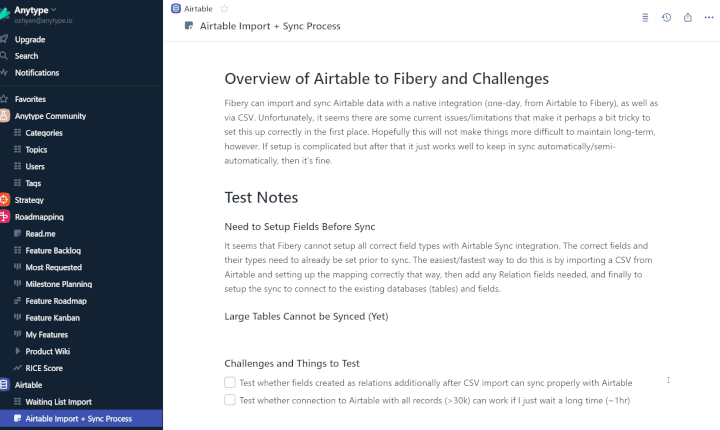
To address the issue of all Views having to show up in the tree menu, Fibery is now working on allowing in-line Views in a Document or Entity. So just as people create their own fully customizable “dashboards” in Notion, so you don’t need to navigate an extensive tree to find a particular view, you will be able to do the same in Fibery in the relatively near future.
ClickUp navigation and organization is more complicated and yet more rigid in many ways. You have very defined levels of hierarchy (Space->Folder->List->Task->Subtask) and only certain things can exist at each level. No smart folders (as of this writing). In my experience you basically want to avoid much use of the left navigation because it can’t really show much (this is being improved, but still limited). You can have multiple “tabs” of views at the top of the main content area on the right, which is nice, but you do not know from the left menu what you will find in the right, or where to find any given thing. You only know it because you use it and memorize it, it’s not actually intuitive or very explorable in my view. Search does not surface Views either (try searching for “Epics backlog” in ClickUp) and is in general quite bad, as I mentioned, so you cannot reliably use it to get around quickly as you can in Fibery (as shown above).
ClickUp also does not respect use of the browser Back/Forward buttons and handles it in a very confusing way. This is especially evident when trying to use Docs in their present state. It has some nice features in its UI to do more sophisticated things (such as expand/collapse a doc, or “pin” a task to the footer), but the inability to use Back/Forward consistently breaks a fundamental design and UX pattern and slows down the user.
Neither tool handles truly large scale organizations that well since the left menu gets cluttered in Fibery, and views get hidden in ClickUp. As I mentioned above Fibery is adding some tools that will help here, and if nothing else its superior search makes navigation faster even with most of the nav tree collapsed. ClickUp is complicated and inflexible, and seems to only be getting more complicated, and so far with no clear ideas for easier structure or more flexibility. To me Fibery wins, but others disagree. ![]() I suppose if your own approaches to organizing content map closely enough to ClickUp then it may be more intuitive, but I’ve seen a lot of new users confused about how to arrange things (and resulting articles and documentation that try to patiently explain something that in my view should be a lot more immediately intuitive: content structure and navigation).
I suppose if your own approaches to organizing content map closely enough to ClickUp then it may be more intuitive, but I’ve seen a lot of new users confused about how to arrange things (and resulting articles and documentation that try to patiently explain something that in my view should be a lot more immediately intuitive: content structure and navigation).
Performance 
Fibery: ![]() (3.5+)
(3.5+)
ClickUp: ![]() (2)
(2)
ClickUp is not always slow, but it is not fast either. Performance is a big, known issue with it (frequent complaints in the ClickUp Facebook group and in their official Canny board), and though it gets better over time, it is not getting better quickly. Fibery performance is not mind-blowing, but it is good, and it is pretty reliable at being “fast-enough”. With large amounts of data Fibery is more performant than ClickUp. (you should just test it and see!)
Flexibility and Data Representation 
Fibery: ![]() (4.5)
(4.5)
ClickUp ![]() (3)
(3)
Fibery is a lot more flexible than ClickUp and this allows you to represent things in a more customized way that is better-suited to each type of data. ClickUp is flexible enough and can represent different things, forum posts, tasks, epics, etc. in an acceptable, usable way. But Fibery can do this far better since it is highly customizable, each database/type/entity can have only what is needed for that specific type of data, Relations and References and many other aspects are more powerful, etc. Just the fact that you can essentially reflect the entire data structure of Discourse (Categories with Topics, Topics with Users and Tags, etc.) inside Fibery in a fairly congruent way is evidence of this fact. ClickUp has been able to adapt a fair amount over time and is now a lot more flexible than it was, but it’s still limited to a “task-like” approach, when some things (like forum posts) just don’t really make good sense to represent this way. I should show some simple examples of this in a future update.
Docs 
Fibery: ![]() (3+)
(3+)
ClickUp: ![]() (3)
(3)
For features, there is no real clear winner between the two for me (at this time). Fibery’s docs are not as sophisticated and full-featured as ClickUp’s are, in general (although there are some feature advantages). There are some blocks and types of formatting missing in Fibery that are present in ClickUp, notably no Table of Contents in Fibery, no real “embeds” or “bookmarks” (in-line preview of pasted URLs), etc. So ClickUp wins here based on number of features/block types.
However there are also some advantages in Fibery as well, and soon the advantages will be more significant as the upcoming “blocks” overhaul in Fibery is implemented (embed almost anything into a Fibery “doc”, views, charts, tables, lists, kanban, plus block-level functions like “react”/emoji, etc.). Fibery also has collapsible (toggle) headers, which can be used for some things that ToC are used for, and are useful to have in their own right (and not just a “toggle block”). Fibery and ClickUp can both make useful links to e.g. Tasks within documents, but Fibery shows more useful info without having to hover over a task for a popup, and you can interact e.g. set Assignee of a task, again without a popup. This is a small but nice thing.
Fibery’s doc organization and integration with the rest of the navigation system is the main area where it stands above ClickUp, in my opinion. Docs can exist anywhere, including inside entities (ClickUp has this too), and there are folders which you can use as much as you want. When you use back/forward browser actions, the navigation makes sense, whereas in ClickUp often it does not (it e.g. takes you completely out of docs when you wanted to just go back to a previous doc). Permissions are more clear in Fibery than ClickUp too, for example it appears that if you create private docs in a hierarchy in ClickUp and then want to share one of those docs with others, it is very unclear how to do this, or if it’s even possible. In Fibery you can easily move docs around between Folders, Spaces, etc. and permissions just depend on the Space it’s in, which to me is very intuitive. There is also a (new) “My Space” view which lets you create anything in a private area and later move (or copy) it wherever you need it.
Integrations 


Fibery: ![]() (4)
(4)
ClickUp: (![]() ) (4+)
) (4+)
Fibery and ClickUp take different approaches to integration. Fibery’s big advantage, that comes from its flexible data model, is that it can generally replicate the data structure of whatever app it is integrating with. If you connect Fibery to Jira, it brings in all Projects, Versions, Issues, Statuses, Users, etc. Sync is generally one-way (source app into Fibery), but once in Fibery you can add fields to augment each data type, and of course act on it with Automations, References, and all other powerful features. This is a fairly amazing superpower, but it only exists for the relatively few other tools Fibery has built integrations for. Some integrations also allow bi-directional sync (writing back to source) but most do not (yet). Fibery also has a good Slack integration, that seems comparable to ClickUp. So Fibery has fewer integrations, but they are generally well-chosen, the major tools in a given area (Jira, Github, Intercom, Airtable, etc.), and they work well. Fibery supports Integromat for further interop.
ClickUp is ahead in some areas, like being able to send via their integrations, e.g. send emails (coming soon in Fibery!), or send texts (Twilio). It also has many more native integrations, including with file storage platforms like GDrive and Dropbox, etc. In some cases these “integrations” are really just embeds, however (e.g. Miro).
It is hard to pick a clear winner. ClickUp’s integrations are more numerous and sometimes bi-directional. Fibery’s integrations are “deeper” and more complete, and require less tool switching in some cases. Probably ClickUp might win by a small amount. But it’s a close call, and Fibery integrations are great (and ClickUp has no forum integration!).
Feedback Management
General 
Fibery: ![]() (3.5+)
(3.5+)
ClickUp: ![]() (3)
(3)
For now this is more of a specific use case of integration as neither tool really lets you gather feedback directly (at least not yet, Fibery is working on this though ![]() ). So it’s a bit of a toss-up in that it highly depends on how you gather feedback (what tools you use) and what integrations are supported by a given tool. If you’re just starting out and haven’t yet settled on a dedicated feedback platform, I might suggest the affordable and flexible Discourse forum for handling feedback and community at the same time, and in that case Fibery would win (more on that below). But if you prefer to use a more dedicated tool, ClickUp may win, at least if Canny is your particular choice. This is because ClickUp has a native integration with Canny, and where such an integration is mature in the ClickUp ecosystem, it is often superior in some ways to a Fibery ad-hoc (e.g. via Integromat) integration, if only because of the ability to do bi-directional data sync easily. This overall reflects differences similar to what I outlined above in Integration more generally.
). So it’s a bit of a toss-up in that it highly depends on how you gather feedback (what tools you use) and what integrations are supported by a given tool. If you’re just starting out and haven’t yet settled on a dedicated feedback platform, I might suggest the affordable and flexible Discourse forum for handling feedback and community at the same time, and in that case Fibery would win (more on that below). But if you prefer to use a more dedicated tool, ClickUp may win, at least if Canny is your particular choice. This is because ClickUp has a native integration with Canny, and where such an integration is mature in the ClickUp ecosystem, it is often superior in some ways to a Fibery ad-hoc (e.g. via Integromat) integration, if only because of the ability to do bi-directional data sync easily. This overall reflects differences similar to what I outlined above in Integration more generally.
Both of them support integration with Intercom as well, however I think Fibery’s flexibility and ability to correlate data together will create a better overall feedback management flow. You can take in feedback from multiple sources, including email, Intercom, forum, or Canny (via Integromat), and then correlate all of that together to common user data. This is where Fibery’s flexibility superpowers start to become evident. But it gets better, as Fibery’s References/bi-directional links functionality lets you literally highlight text in one Entity (or Doc) and link it to another. ClickUp has backlinks and whatnot, but it doesn’t have the same highlighting, references, and “transclusion” model, so it requires a lot more jumping around to the linked source entities to actually make sense of linked feedback. Fibery wins here already, and will continue to extend that lead as they pursue their goal of “augmenting organizational intelligence” (see below for more on that).
Fibery should also be able to do a better job bringing in data from other tools where no native integration exists for either Fibery or ClickUp, for example Product/Market Fit surveys, and other analytics. With Fibery’s flexibility this can allow a team to interact with, correlate, quote, and otherwise make better use of that data together in the same system. But as previously noted, if ClickUp has a pre-built integration for something, that integration does work generally fairly well, and in some respects better than Fibery, e.g. bi-directional updates.
Forum-based Feedback Management 
Fibery: ![]() (4.5)
(4.5)
ClickUp: ![]() (2.5)
(2.5)
This is a specific case of feedback management that occurs frequently for my clients thus-far (there is a feedback loop bias though because I also recommend Discourse for community much of the time ![]() ). Here Fibery further extends its lead since it has a native Discourse integration, and as previously noted its integrations are great when developed directly by the Fibery team. Fibery’s integration with the Discourse forum platform (that also powers this digital garden!) is truly excellent, and if you use that for feedback management instead of a dedicated tool like Canny, Fibery will likely best serve your needs.
). Here Fibery further extends its lead since it has a native Discourse integration, and as previously noted its integrations are great when developed directly by the Fibery team. Fibery’s integration with the Discourse forum platform (that also powers this digital garden!) is truly excellent, and if you use that for feedback management instead of a dedicated tool like Canny, Fibery will likely best serve your needs.
All categories, tags, topics, messages, and users are pulled into Fibery automatically and exist as separate Entities that can be easily navigated, and even augmented with additional fields of data, or linked together automatically or manually. You cannot reply to the forum from Fibery (yet…), but you can do a lot of other powerful stuff, like check stats of users, multiply value of their feedback based on activity, mark for follow-up or include in changelog, etc. ClickUp has no native integration with any forum tool, so it must be setup manually through Integromat, and the data is not nearly as clean or complete. It’s much harder to work with and maintain over time.
As I mentioned above Fibery is also moving toward native feedback management functions, but these are unlikely to replace the overall need for “community” tools (e.g. chat, forum, user-to-user help, etc.). It’s really focused more on user-to-company feedback, specifically in the form of bug reports and feature requests. Using a forum for feedback management now, while such features don’t exist in Fibery, gives you a pretty natural migration path once those features are implemented: the forum feature requests are already in Fibery, so you just set permissions to expose those back to the world, close your Feature Request category in the forum, and continue the rest of the community spaces as normal. You can then take in further feedback on new (native in Fibery) and old (imported from Discourse) feedback without skipping a beat or losing any data. This does not seem to be a direction ClickUp is heading in at all.
Additional Features 
Fibery: ![]() (3.5+)
(3.5+)
ClickUp: ![]() (3+)
(3+)
ClickUp has more features, but Fibery’s features are generally better implemented. For example the graph/data visualization system in Fibery is extremely powerful, and in the upcoming “blocks” update you will be able to embed a flexible, interactive chart into any page, any document, any entity, etc. The White Board is functional, and links well with the rest of the system (add Entities to white board, etc.).
ClickUp has many features, whiteboard, mindmap, time tracking, and more. The quality of implementation varies quite a lot though, even after a long time of polishing (Docs 2.0 for example is still not very smooth, whiteboards were introduced recently and were extremely buggy). Some tools are great, others are not. If the features you need right now are nicely polished, then that’s great, but if you’re counting on the availability of so many features all in one tool (a big selling point of ClickUp) you may sadly find that in reality, once you get to actually trying to use a given feature in earnest (e.g. mindmaps), it may be quite buggy and not really capable of handling actual work. You won’t know until you try! I’d love to see more of a plugin-based or “labs” approach from ClickUp to gradually bring these features in over time.
Mobile App/Compatibility 
Fibery: ![]() (1)
(1)
ClickUp: ![]() (4)
(4)
Fibery has no mobile app and even much of the web interface is not really usable on mobile (this is being slowly improved, but definitely too slowly if mobile is at all important to you). ![]() ClickUp has a nice, well-liked mobile app. No contest. If you need mobile, Fibery is probably not going to work for now.
ClickUp has a nice, well-liked mobile app. No contest. If you need mobile, Fibery is probably not going to work for now. ![]()
Future and Vision 
Fibery: ![]() (4+)
(4+)
ClickUp: ![]() (2.5)
(2.5)
This is admittedly a rather speculative and subjective category, but it’s also one of the reasons I most like Fibery: they have a really clear and valuable overall goal paired with a visionary, experimental, and iterative approach to reaching it. They want to “augment organizational intelligence”, not just “replace all your apps” (my paraphrase of a common ClickUp marketing message). This means they work on implementing innovative things like “context-preserving navigation”: [DONE] Multi-panel context-preserving navigation - #18 by mdubakov - Ideas & Features - Fibery Community (and you can enable this in beta already) as well as “Feed view” (imagine it for triaging feedback!) [DONE] Feed View - Ideas & Features - Fibery Community ClickUp, in contrast, works more on major areas of functionality and features that are exemplified by whole other apps, e.g. mindmaps (like Miro), time tracking (Toggl), etc. But the actual UX of the apps and each area seem to get a lot less creative and deeply considered improvement vs. Fibery. Fibery also “works in public” on all this, which for me helps establish a lot of trust.
In general the Fibery team appears to think deeply about the overall problems they’re trying to solve, rather than focusing on how specific other tools and workflows work and then just trying to replicate that. In contrast I think ClickUp does more of the latter: see a feature in another app (Docs or Whiteboards, for example), and then just try to implement it in ClickUp, but seemingly without much deeper thought or cross-department communication about how to do that in a way that gives the best, smoothest, most integrated and functional experience. As a result the level of quality of the ClickUp app varies quite a lot, and some things are just poorly implemented. It’s a nice idea to try to replace lots of tools and have all work in one place, but just trying to implement every other tools’ function without a good plan and vision does not work that well.
Conclusion
Clearly I ended up liking Fibery more than ClickUp. But I started out this comparison in that position, and that makes me biased.
That said, I honestly didn’t expect to end up with such a feeling of confirmation in my preference. And it was the core issues I encountered with ClickUp that most cemented this, particularly in Search, Performance, and Navigation. While I was impressed with the sheer breadth of features it offers, I ultimately came away simply feeling like I would not be confident to do my work in it given those seemingly core problems (which affect almost every aspect of working with the system). The ability to feel stable and confident in your work management tool seems to me to be the most important thing, more so even than the existence of any particularly desired feature or how sophisticated it might be.
Maybe I got unlucky and ClickUp was having particular issues the week I tested it, though subsequent re-tests in later weeks of particular things like Search yielded similarly poor results. And judging by the long-term feature requests and extensive discussion of issues like performance in their Canny feature vote board, this may indeed simply be a consequence of their rapid development and release schedule, and their attempt to incorporate almost every type of work management function into one UI as fast as possible. I like the idea of what they’re trying to do, and in the past have really admired their regular release schedule, but it seems it may be coming at too great a cost, at least from my perspective and experience.
Fibery is an interesting tool. It doesn’t actually win here on features that are core to an Agile management workflow. In fact other tools like Jira may be better if that’s really what you need and your requirements are focused solely on that. But in my experience almost every team ends up needing more beyond feedback and dev management, and that’s where Fibery’s benefits start to show. The ability to deeply integrate all your work functions and data into one platform, in a way that is reasonably customizable to the needs of each area, while not running into the problems of having too much single-purpose functionality (which may be unneeded or poorly implemented), makes Fibery a good balance for more broad work needs. But there’s no doubt that it is harder and more time-consuming to get started with initially!
So the decision remains a bit non-trivial. But personally I’d rather put in time up-front to configure a system that works well for me and my team, and have minor maintenance over time, but an otherwise smooth-running and performant system (i.e. Fibery), rather than get started quickly and easily, but run into flakiness, performance issues, limitations, etc. (ClickUp).
What do you think? Have you used or tested both tools? Or is there a different one you’d recommend even more?
